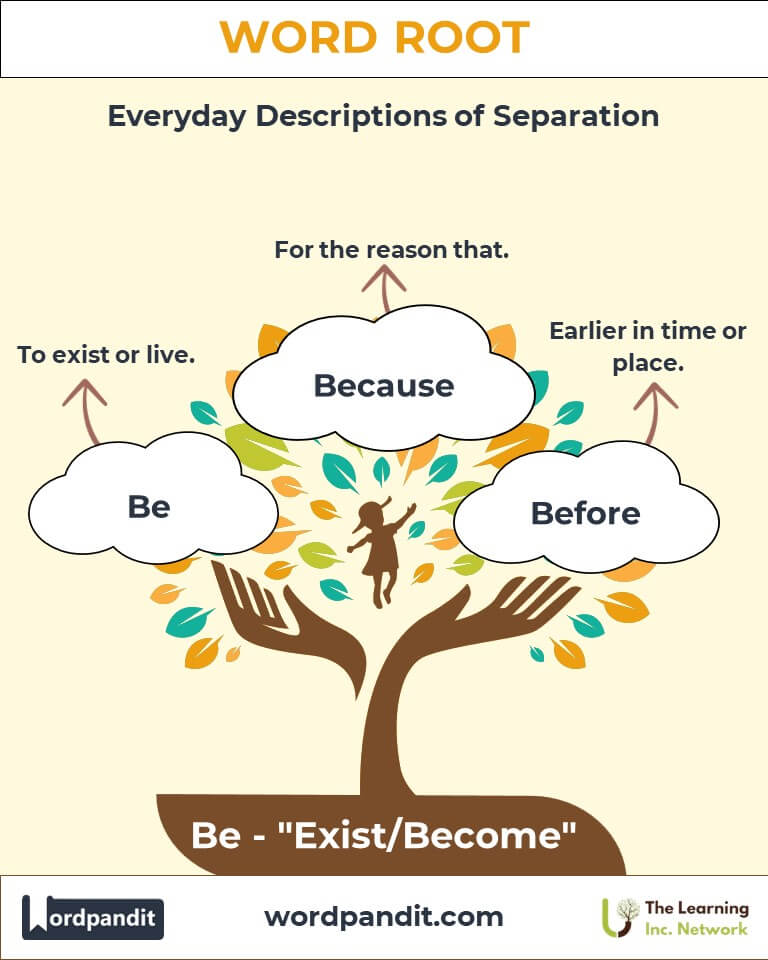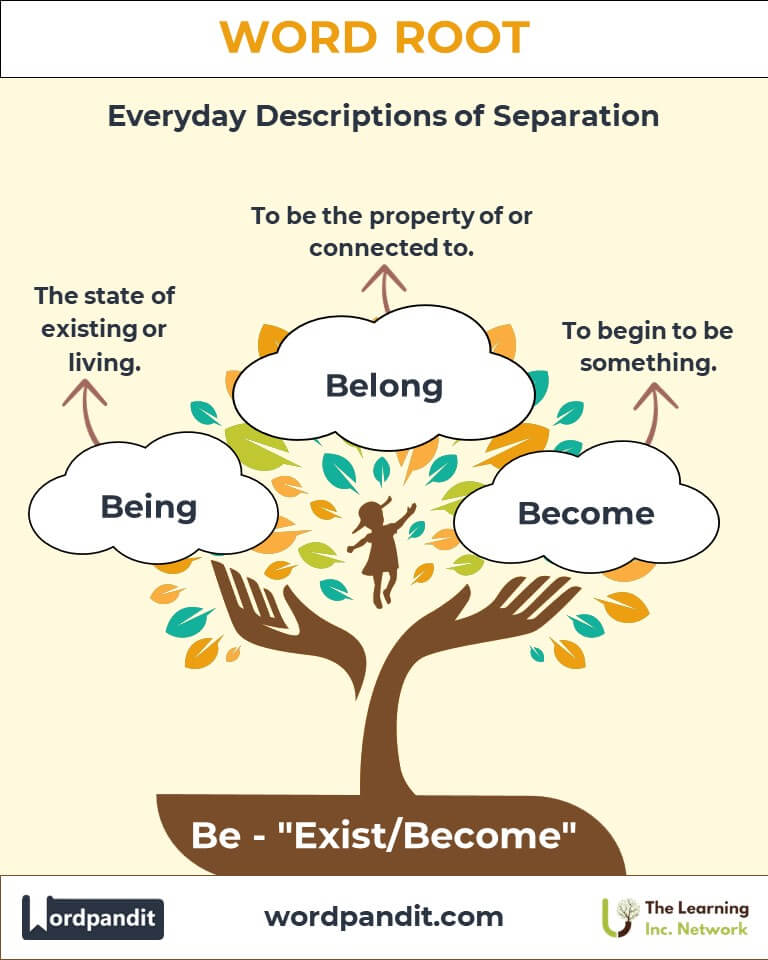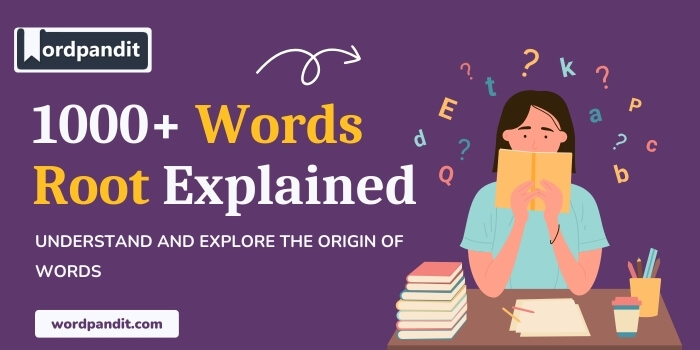Be: The Essence of Existence in Language and Philosophy
Explore the deep-seated linguistic and philosophical significance of the root "Be," from its origins in ancient language to its applications in modern vocabulary and existential thought. Discover how this root forms the backbone of some of the most fundamental concepts of being, life, and presence.

Table of Contents
- Introduction: To Be or Not to Be – The Power of "Be"
- Etymology and Historical Journey
- Mnemonic: Unlocking the Power of "Be"
- Common "Be"-Related Terms
- "Be" Through Time
- "Be" in Specialized Fields
- Illustrative Story: "Be" in Action
- Cultural Significance of the "Be" Root
- The "Be" Family Tree
- FAQs About the "Be" Root
- Test Your Knowledge: "Be" Mastery Quiz
- Conclusion: The Living Legacy of "Be"
1. Introduction: To Be or Not to Be – The Power of "Be"
What does it mean to "be"? This simple question encapsulates centuries of philosophical inquiry and linguistic evolution. The root "Be" derives from Old English beon and Proto-Germanic biju- meaning "exist" or "live." Pronounced simply as "bee," it serves as a linguistic cornerstone for expressing existence, states, and essential qualities. In grammar, it acts as a verb of being, forming the core of existential and descriptive statements in countless languages. Its influence extends beyond grammar into philosophy, literature, and modern psychology.

2. Etymology and Historical Journey
- The word root "Be" finds its origins in the Proto-Indo-European root bheu- or bheue-, which signifies "to grow," "to become," or "to exist."
- Old English forms like beon (future tense) and wesan (present tense) reflected nuanced concepts of existence and transformation.
- The evolution into Middle and Modern English solidified its role as a fundamental linguistic and philosophical concept.
3. Mnemonic: Unlocking the Power of "Be"
To remember "Be," think of the phrase: "Be is the beginning of being, bridging existence and expression." Visualize a bridge connecting two realms—potential and reality. The "Be" root anchors this bridge, enabling transformation and existence.
4. Common "Be"-Related Terms
- Being: The state or quality of existing.
Example: "The meaning of being has puzzled philosophers for centuries." - Become: To begin to be; to transform into a state.
Example: "With practice, she became a skilled musician." - Belong: To be part of or connected with.
Example: "This book belongs to the library collection." - Believe: To accept as true or real.
Example: "He believed in the power of community." - Beware: To be cautious or alert to danger.
Example: "Beware of false promises."
5. "Be" Through Time
- Old English: Beon denoted both existence and transformation.
- Middle Ages: Philosophers explored its connection to divine existence.
- Modern Era: Existentialists like Heidegger redefined "being" as central to human consciousness.
6. "Be" in Specialized Fields
- Philosophy: Central to existential and metaphysical inquiries about the nature of existence.
Example: Heidegger’s concept of Dasein explores human "being" in the world. - Psychology: Understanding self-awareness and identity revolves around the essence of "being."
Application: Studies in mindfulness emphasize "being present." - Linguistics: The verb "be" anchors syntactic structures in English and other languages.
Fun Fact: In English, "be" is one of the most irregular yet indispensable verbs. - Literature: Themes of existence and transformation often center on variations of "be."
Notable Example: Hamlet’s soliloquy, "To be or not to be," highlights the existential dilemma.
7. Illustrative Story: "Be" in Action
Dr. Elena Ortiz, a linguist, pondered over her latest discovery—a dialect where "be" was replaced with a symbol. In her research, she uncovered how omitting the verb influenced speakers’ perception of reality. The lack of explicit "being" altered their cultural outlook, fostering a unique minimalist worldview. Armed with this insight, Dr. Ortiz wrote a groundbreaking paper, advocating for the preservation of linguistic diversity to safeguard humanity’s existential awareness.
8. Cultural Significance of the "Be" Root
From Shakespeare’s plays to Zen teachings, "be" permeates culture as a symbol of existence and mindfulness. The word’s simplicity and profundity resonate universally, making it a key theme in art, religion, and literature. For example, Buddhism emphasizes "being in the moment," while Western philosophy explores "being" as a measure of self and purpose.

9. The "Be" Family Tree
- Am/Is/Are: Variants of "be" that indicate different tenses or states.
- Exist: From Latin existere (to stand out), expressing presence.
Example: "Does life exist on other planets?" - Live: Rooted in Old English libban, denoting active being.
Example: "She lives a fulfilling life."

FAQs About the "Be" Root
1. What is the origin of the root "Be"?
The root "Be" originates from the Proto-Indo-European root bheu- or bheue-, meaning "to grow," "to exist," or "to become." It passed through Proto-Germanic (biju-) and Old English (beon), evolving into the modern English verb "be." This rich etymological history reflects the root's fundamental role in expressing states of existence across time and cultures.
2. Why is "be" considered such an essential verb in English?
"Be" is central to English grammar as it expresses existence, states, and identity. It functions as a linking verb (e.g., "She is happy"), auxiliary verb (e.g., "He is running"), and forms various tenses. Without "be," English would lack a cohesive structure to articulate being, states, and actions.
3. How is "be" used differently in other languages?
While most languages have verbs equivalent to "be," their use varies. For instance, in Spanish, "ser" and "estar" both mean "to be" but are used differently based on permanence. Some languages, like Russian, omit "be" in the present tense altogether (e.g., "I student" instead of "I am a student").
4. What is the philosophical significance of "be"?
Philosophers like Heidegger and Sartre explored "being" as central to human existence and consciousness. "To be" raises questions about identity, purpose, and the nature of existence, making it a cornerstone of existential philosophy.
5. How does "become" expand on the meaning of "be"?
"Become" combines the root "be" with transformation, signifying a transition into a new state or condition. It conveys a process of growth or change, bridging static existence with dynamic transformation.
Test Your Knowledge: "Be" Mastery Quiz
1. What is the root meaning of "be"?
2. Which philosopher is most associated with the concept of "being"?
3. How does "be" function grammatically in English?
4. What does the term "beware" mean?
5. Which of the following best demonstrates the transformative aspect of "be"?
12. Conclusion: The Living Legacy of "Be"
The root "Be" encapsulates existence itself, forming the bedrock of language and philosophy. Its enduring relevance lies in its ability to connect us with profound questions of life and identity. Whether in linguistics, literature, or mindfulness, "be" continues to inspire and define human thought.












